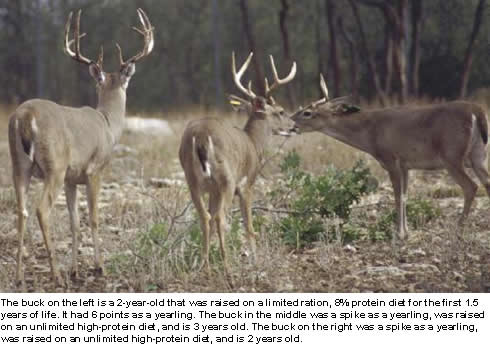White-tailed Deer
Genetic and Environmental Interaction in White-tailed Deer
Conclusions
How much of antler growth is genetic, and how much is nutritional?
All antler growth is genetically based and environmentally influenced. Nutrition is an environmental influence. In order to grow deer with large antlers, a manager should manage for the best genetic deer possible, and simultaneously manage the habitat for the best nutrition possible. This will insure those deer reach their genetic potential. In order to improve habitat for most of the Hill Country, many deer must be removed from the range. While harvesting deer, why not select for higher-quality antlers by removing poor-quality bucks (including yearlings)?
The genetic makeup of an individual deer may be masked by optimum nutritional conditions. As mentioned in the overview of this study, there is a group of deer called "swing deer" that performs poorly during drought years, and performs well during the good years. "Swing deer" slow management results. What the land managers and hunters must remember is that there is another group of deer that performs well even under the most stressful of conditions. This latter group of deer contains the bucks that should be left on the range for breeding, whereas the former group of deer should be removed from the population.
Antler characteristics can be improved by selecting for animals that perform well under adverse conditions, as opposed to animals that perform well under optimum conditions.
The best time to make selection in a deer herd is during times of nutritional stress (e.g., drought). These times make the "swing deer" show their true colors (spikes), making them easier to select for removal.

Management Implications
Antler traits are heritable; therefore, selection will work. The degree of success is directly proportional to the intensity of selection placed on the herd.
Selection based on yearling antler development can increase herd potential.
Recommendations or regulations that impose antler restrictions and offer protection to spike-antlered yearling bucks will effectively reduce future antler potential in a deer herd. For example, if your hunting club restricts harvest of any buck with less than 6 points, you will see a reduction in antler quality over time.
"You can starve the antlers off a deer with good genetic potential, but no amount of feed will produce big antlers on deer with poor genetic potential." -- Dr. John Williams